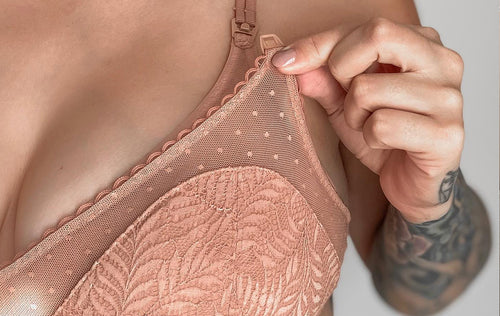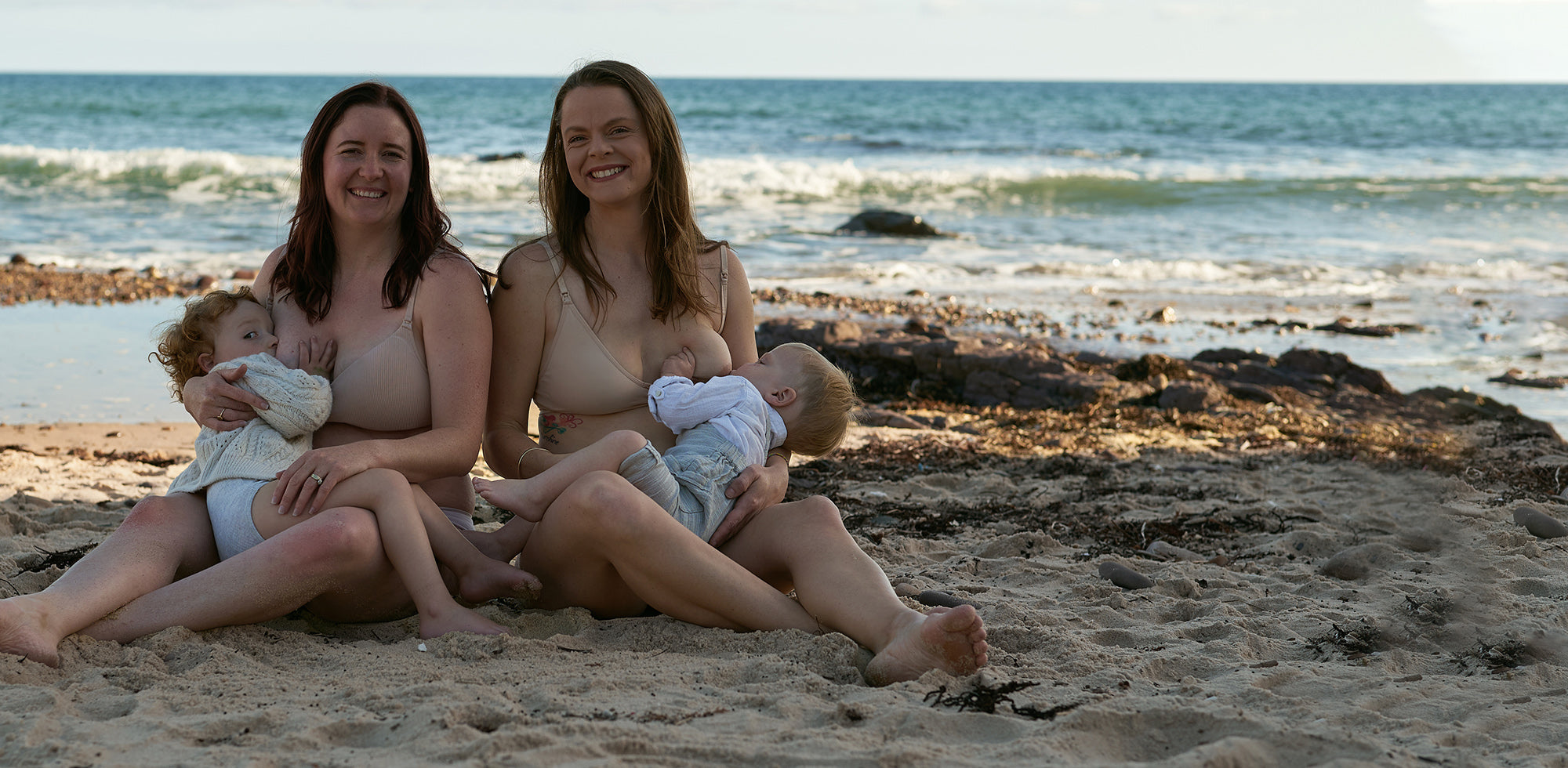Different Types of Breast Pads and
How to Choose the Best Ones

Breast pads, which are also commonly known as nursing pads, are an extremely important breastfeeding accessory. They absorb breast milk from leaking breasts to help prevent embarrassment and preserve your clothes from stains when worn in a conventional or nursing bra.
Why do breasts leak?
In the early days of breastfeeding, as the quantity of your breast milk adjusts to your baby's demands, leaking is quite common. Your breasts may leak for a few weeks or for as long as you are breastfeeding your baby. However, some women do not notice any leaking at all. This is also normal.
Leaking can happen for many reasons: when you hear your baby scream, when your breasts become full, when you are intimate with your partner, or even for no apparent reason.
Therefore, leakage of milk is a common symptom of the let-down reflex. It's frequent in the first few weeks after childbirth, when you're weaning the infant, or when you're reducing breastfeeding sessions and you become engorged. It happens because the body takes some time to adjust to the reduced requirement for breast milk.
Breast pads keep wetness from spoiling clothes and causing skin irritation, and certain breast pads may even provide extra support for the breasts. They can also act as a nice cushion between your bra and your aching nipples from breastfeeding.
So, when do you need nursing pads?
- When your milk first comes in during the first few weeks of breastfeeding
- If you'll be gone from your baby for more than a few hours,
- When you're ready to return to work
- If you have an overabundance of breast milk
- During sexual encounters
- When you're sleeping at night
Choosing the right breast pad for you
Choose cotton nursing pads that are soft and absorbent. Avoid pads with waterproof or plastic inserts that might trap moisture against your skin. Your nipples need to breathe as much as possible. If your nursing pads become wet, you should replace them immediately.
Constant contact with wetness against your breasts can cause skin irritation and sore nipples, as well as create an environment conducive to yeast and bacteria growth, which can lead to diseases like thrush and mastitis.
Different types of breast pads
Breast pads are available in a wide variety of styles, shapes, and sizes. There are also disposable and reusable options. Some come with adhesive strips to keep them in place in your bra and prevent them from slipping. Others are contoured to follow your breast shape.
- Disposable nursing pads: These are intended to be used once and then discarded. Because they come in a range of shapes and thicknesses, you might want to experiment with a few different brands to determine which one you prefer. Because you won't have to worry about washing disposable pads, they're ideal for going out or traveling. On the downside, while cheaper to buy once, their cost can quickly add up over time because you have to keep buying new ones.
- Reusable nursing pads: These are more cost-effective because you may wear them, wash them, and reuse them again and again. They're also good for the environment because you won't be tossing away many pads every day (and they won't end up in a landfill). You'll need to buy many pairs because you'll need to change them frequently and want to have a couple of pairs on hand while the others are being washed.
- Silicone nursing pads: These are not absorbent. Instead, they work by applying mild pressure on the breast to avoid leaks. These pads are made of soft silicone and feature a sticky surface that sticks to your breast, allowing you to wear them with or without a bra. They're frequently worn under formal attire or while swimming.
- Homemade breast pads: Nursing pads can be made from a number of materials. You can cut disposable diapers or sanitary pads to fit inside your bra, fold a handkerchief or other piece of cotton material and place it over your breasts, or sew a couple of layers of absorbent material into a circular shape and use that, or any other solution that's comfortable for you. While making homemade breast pads, avoid using artificial synthetic materials. Go for 100% cotton because it's better at absorbing leaks and feels nice against your skin.
- Hydrogel pads: These aren't meant to be used for leakage. They're used to soothe and heal sore nipples, and they can be stored in the refrigerator or freezer for cool relief. Hydrogel pads may be beneficial if you have sore or cracked nipples.

How to use breast pads
Follow the steps below to learn the best way how to use breast pads:
1. How to use breast pads
- Wear your bra before putting on your bra pads
- Slide the pad over the nipple gently so that it covers the entire nipple.
- If you notice moderate irritation, apply nipple cream or lanolin to the painful nipple before putting on the bra.
- You can use breast pads for both regular and nursing bras
- If the pads move out of position as you go about your day, simply reposition them or replace them if they become too full.
2. Taking off the breast pads
- Take off the bra first to remove the breast pads. If the breast pads are stuck to your breasts, gently peel them away to avoid skin irritation
- If the pads are stuck to the breast, dampen them with water to make them easier to remove
- Fungal infections or thrush can thrive in the environment created by dry milk and a lot of moisture in the area between your breasts and your breast pads. Before putting on a new pad, wipe your breasts and nipples with a clean cloth or mild soap and warm water.
3. Changing the breast pads
- When your nursing pads feel too damp, it is time to change them
- If you have disposable pads, discard them after each use
- If you have reusable pads or homemade pads, soak them in warm soapy water and gently wash them with your hands.
- Silicone pads can be reused a specific amount of times before they need to be replaced. Check the cleaning recommendations and the usability limit provided by the manufacturer.
How to choose the best breast pad
Here are some of the things to keep in mind when choosing the best breast pad:
- What are your needs? You need to think about your requirements before buying the breast pads. Consider how long you plan to breastfeed, your budget, and whether you'll express or breastfeed your baby.
- If you plan to breastfeed your little one for more than six months, reusable breast pads are recommended because they are less expensive and more environmentally friendly.
- If you're on a budget and have passed the early stages of excessive leakage, handmade breast pads might be a good option.
- Choose a breast pad with a cotton or fabric liner, or any other absorbent material as a liner. Breast pads with plastic liners will not absorb leakage and should be avoided.
- Avoid using facial tissue or toilet paper as nursing pads. They will dampen really quickly and fall apart as soon as they do, leaving you with an even bigger mess.
- If you are using a breast pad and still getting leaks, consider getting a larger breast pad.
- If you notice lumps, hardness, discomfort, or bleeding in your breasts, consult your doctor as it could be a plugged duct or an infection called mastitis.
Breast pads that are either washable or disposable and do not have plastic or waterproof liners allow more air in and help to keep infections at bay.
Silicone breast pads may also be preferable for certain women. To find out which breast pad is ideal for you, talk to your lactation expert. You may have to try a few different brands and sizes before finding the one that's right for you.
Final Thoughts
Choosing the right nursing pad for you is not that difficult. The first step is to get the right type of breast pad for your needs. This will depend on your requirements, budget, nursing duration, and level of comfort that you are searching for.
To avoid inflammation, apply a nipple cream or lotion whenever you notice any sore or cracked nipples. Finally, always wear your bra and follow the breast pad directions for putting it on and taking it off. Do this and you’ll get to enjoy the freedom and comfort that comes with wearing a quality breast pad that works as it was designed. Imagine never having to worry about accidental leakages ever again! That’s what these nursing pads can give you!
What to Look For in a Nursing Bra
Mar 23, 2022 SamanthaHoare
When should you start wearing a nursing bra?
Feb 11, 2022 SamanthaHoare
Shopping for a nursing bra? Here are some common mistakes to avoid
Feb 11, 2022 SamanthaHoare
Nursing Bra Shopping Guide
Feb 10, 2022 AngeliaSmith
What's a Nursing Bra and Why Every Mommy Needs it
Jan 12, 2022 AngeliaSmith
5 Things To Look For in a Nursing Bra
Dec 21, 2021 SmithAngelia
SUBCRIBE FOR NEWSLETTER
Shop today with 10% OFF your first order of all products storewide











